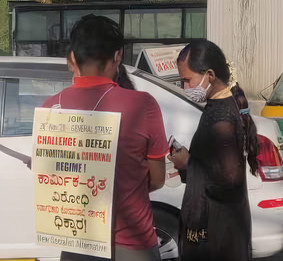This article was originally published by the Committee for a Worker’s International (CWI)
by Jagadesh G Chandra, New Socialist Alternative (CWI India)
Despite the widespread repression under the blatantly right-wing Bharatiya Janata Party-Modi regime, the all-India general strike on 26 November, involving more than 250 million workers (the Joint Committee of Trade Unions- JCTU claimed the number as 300 million-plus) seems to have set the tone for the battles ahead.
Indian trade unions condemned the arrests of workers’ and farmers’ leaders across the country as they demonstrated together in one of the biggest ever nationwide general strike. Earlier almost ten weeks ahead, the ten trade unions spanning from Congress Party-led INTUC, to CITU affiliated to Communist Party of India (M), and others on the left, had called for an all-out general strike mainly focussing on the repeal of anti-worker labour codes (http://www.socialism.in/?p=12201) and the despicable anti-farmer agricultural laws hurriedly brought in by the BJP government of the day.
All over the country, both public and private sector employees participated in the strike. The united front of the over 250 farmers organizations, the All India Kisan Sangharsh Co-ordination Committee (AIKSCC), extended support to the trade union strike, and the unions extended their support to the farmers’ “Chalo Delhi” (March to Delhi) mobilization on 26 and 27 November.
As this article is being written farmers in their millions, (estimated as around 15 million) are still protesting against the recent anti-farmer laws. These aim at withdrawing the government’s minimum support price for farm products, which will seriously affect the income and livelihoods of not only the land-owning farmers but would drive down further the starvation wages of the vast majority of landless peasants and agricultural workers. They form the majority of India’s population living in the hinterlands of rural India.
Trade unions and farmers’ organisations rightly had expressed their concerns. Using Covid-19 as an excuse, the Modi regime unleashed a type of coup against the people in all spheres of society, economy, and politics. Using the fear of coronavirus infection, the Modi regime has played continuous havoc on the working people and oppressed sections of the population in the last nine months or so. Under the pretext of covid-19 an undeclared emergency has been imposed throughout the country, against the right of dissent. Protests have been curbed to the maximum in many BJP ruled states. Even venues of popular protests are out of bounds for ordinary people. Local bans on protest gatherings have been imposed in many cities. In cities like Bangalore police imposed fines to the tune of millions of rupees on organisations who call for the protests.
Brutal treatment of migrant workers
The entire world is a witness as to how the migrant workers were treated during the most shoddy and brutal lock-down that India faced. Poorly paid workers and their families were forced to travel on foot to reach their home states and villages, which are an entire country away in distance. Horror stories abound of how many toilers walked thousands of kilometres with blistered and bleeding feet. In some districts of Uttar Pradesh (U.P) the returning workers were hosed with pesticides under the pretext of containing the virus from entering the villages.
Though the official claims of Corona fatalities are just under a million deaths, the real picture of the ghastly pandemic damaging the lives of millions of people is unbelievably higher at least ten times the establishment figures. Now with the second and third wave of the pandemic spreading very rapidly in the densely populated cities, the future under this government of Modi is of a graveyard scenario. Under the growing pressure of working people, the capitalist governments of the west loosened their purses and came up with stimulus packages to provide some temporary succour to people like furlough pay, etc., The Modi regime and the State governments ruled by BJP played with mere high-sounding words and bombastic numbers.
Given this background, we could have expected much bigger participation and extremely militant reaction during the 26th November general strike, but the fear of Corona and near lock-down situation in many states muted the response of the workers, in general. There was hardly any preparation in the run-up the general strike explaining the issues at stake. A repeat of the lackadaisical attitude of the leadership of the trade unions was very evident in many states. Yet another opportunity has been lost which could have paved the way for a do or die battle against the Modi regime. The attacks unleashed by the Modi regime on the fundamental rights of the working class are surely building enormous class anger beneath the surface.
Mammoth resistance of the farmers
Alongside the general strike, another militant action has been set in motion by the farmers who have travelled to the capital, New Delhi, with the resolve to see the repeal of newly introduced Farm Laws (http://www.socialism.in/?p=12283) which are blatantly anti-farmer. Farmers mainly from Punjab and Haryana, who number 15 million, assembled in the capital demanding the repeal of the new Farm Legislations (they insist that a special session of the Parliament is called to repeal the laws). Perhaps one could term this congregation of farmers as the ‘Occupy’ moment of India.
The Delhi and Haryana state police have unleashed wide-scale repression on the farmers and their families who have camped in the capital. Police used violent means to attempt to stop hundreds of thousands of workers and farmers who were on their way to Delhi to demonstrate peacefully in the capital city on 26 and 27 November. But nothing has deterred farmers of their resolve to fightback The BJP is on the back-foot. And uniquely this time the general strike was followed by the mass agitation against the farm legislations. The indications are that the Modi regime is searching for a face-saving formula to extricate itself from the situation.
Future battles
The Modi “reforms” spree that has galloped with a breakneck speed is unparalleled in the economic history of India. It upset the economic and social fabric of India, which until the 1990’s “reforms” cocooned with various degrees of protectionism, combined with Keynesian measures. But even the infamous reforms of 1991 under the Congress Party regime, however, “path-breaking”, could not straight away usher in aggressive neo-liberalism. This was because of the various socio-political factors prevalent in a history of anti-colonialism and anti-imperialism.
Previous governments headed by Congress, including that of Indira Gandhi, dabbled with their own concoctions of “socialism”, which were a diluted form of the left of center social democracy. Many economic pundits too, for their own “analytical necessities”, have dubbed the economic management under the regimes led by Congress stalwarts as a “socialistic pattern” – a mixed economy or middle of the road economy.
But the edifice of this false notion got exposed and crumbled in the aftermath of the post-war boom which came to an end very soon in the late Sixties of the last century. The people who since the advent of Modi, in 2014, were under the spell of Hindutva identity politics, are beginning to flex their muscles through direct class actions and mass agitations. The 26th November general strike and the farmers’ “Occupy Delhi” agitation are a whiff of fresh air, which establishes the fact that the so-called invincible Modi can be brought to its knees.
Those who academically talk of “new forms of struggles” and sneer at the trade union strikes and mass agitations forget the fact the strength lies in the organised numbers and the centrality of the working class. It is imperative that the demands of the trade unions should go beyond the usual customary list of minimum demands. The left needs to face up to the fact that just mere sloganeering against the Modi regime being “fascistic” will not suffice. The resistance has to be built on the streets with clear political slogans of regime change and system change. India’s working class has time and again proved that given the leadership it has the necessary revolutionary resolve to end this greedy profiteering capitalist system and build a new socialist alternative.

